Daiwa Keiryu-X
The Daiwa Keiryu-X rods have a few things going for them. 1) they collapse down to just 15.6" so they will fit entirely within a modest daypack. 2) They are robust. They are less likely than most rods to break from a moment's inattention. They are less likely to break from a larger than expected fish. 3) They are inexpensive in relation to other rods that will fit inside a backpack. 4) They are stiff enough to get good hook sets when fishing deep pools or runs with heavy flies.
Every silver lining has a cloud, though, and the Daiwa Keiryu-X rods also have an attribute which for serious anglers could be a deal breaker. They are seriously stiff rods. The Keiryu-X 36 has a penny rating of 36, which is twice the rating of the TenkaraBum 36.
When I first started importing the Daiwa Kiyose SF series of rods, which is the immediate predecessor of the Keiryu-X design, I described them as being excellent for Czech nymphing. They were and the Keiryu-X rods are really very good at getting immediate, positive hook sets when fishing heavy flies in deep or fast water. However, in the years since then, I have learned more about fishing weighted nymphs and specifically, more about how fish spit out flies.
To get the most benefit out of a stiff rod when fishing weighted nymphs, you pretty much have to be fishing directly upstream, or up and only slightly across. If fishing across or down, you will feel the take, but when you try to set the hook the fish will be gone.
Watching underwater video of trout spitting out flies reveals that they spit the fly back upstream. They may mouth a fly like a Killer Bug for a half second before spitting it out. You have two goals 1) detect the take and 2) prevent the spit.
You can detect the take by feel or by sight. If you are leading the nymph(s) downstream with a tight line, feeling the take is easy. The only probem is that the fish are likely to be faster than you are. If you can feel them, they can feel you - and they are quicker to react. In that case, your only hope is that the hook catches on the way out when they spit it upstream. If your line is tight and is pulling downstream, it is harder for them to spit the fly back upstream and the hook will catch in the corner of the mouth (if you're quick enough and lucky enough).
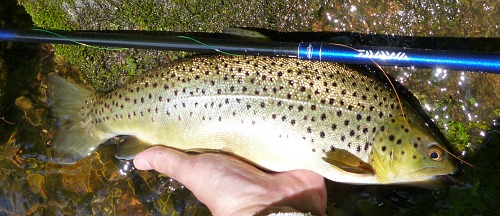 Trout caught with Kiyose 30SF, fishing a heavy nymph directly upstream.
Trout caught with Kiyose 30SF, fishing a heavy nymph directly upstream.When fishing across or down the scenario is the same except that your line angle will not prevent the fly from going upstream the inch or two required for a successful spit. By the time you react and strike, you will pull the nymph away from the fish, not back into the corner of it's mouth.
If you fish a heavy line (size 4 or even 4.5 level fluorocarbon or the Nissin PALS SP Pro) you will get line sag. Line sag will cause more of your tippet to be in the water and subject to drag. If you are fishing across, at least part of the tippet is likely to be in water that is flowing at a different speed than the water surrounding your fly. That will pull the fly towards you. If you are fishing almost directly upstream the pull will be downstream (which is pretty much what you want to make it harder for the fish to spit out your fly).
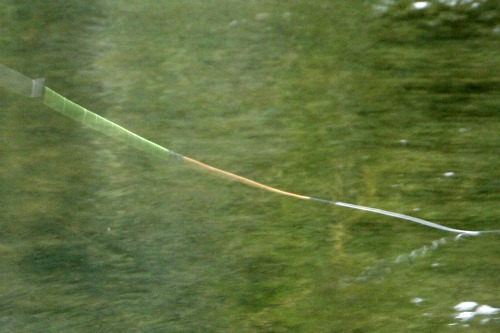 The Sag The Sag |
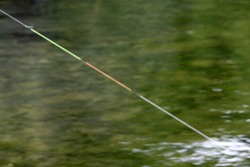 The Take The Take |
The images above show the TenkaraBum Tactical Nymphing Sighter, which is considerably lighter and has less sag than a size 4 fluorocarbon line.
There is an upside to line sag, though. It produces an extremely sensitive strike indicator. When a fish takes the nymph, the line will straighten and the sag will disappear. However, that straightening of the line puts very little tension on the fly - much, much less than if the line was already tight and the pull was against your rod tip. After experiencing trout spitting out live bait when they feel line tension, I am convinced that for trout, line tension is a bigger danger signal than a hard fly that tastes like chicken (feathers).
It is actually very good that a heavy line can be used as a sensitive srike indicator because you will need a heavy line to load the stiff rod anyway!
That's all a pretty long explanation of why the Keiryu-X rods are good at fishing heavy nymphs directly upstream.
The flip side of the coin is that the stiff rod and heavy line are not the greatest at fishing unweighted wets and are not at all what you want if you want to fish diminutive dries.
The rods are great for backpacking in that they fit entirely within your pack and are less likely to break when you are three days into a six day trip. You have to weigh that against how you will fish, though. If you plan on fishing heavy nymphs most of the time it is a win-win. If you plan on backpacking to a spot where you will fish dries and some small bead heads, it is more of a win-lose-draw.
If the backpacking is more important than the fishing, these are really pretty good rods for the price. If the fishing is more important than the backpacking, save your pennies and buy a Tenryu Furaibo TF39TA.
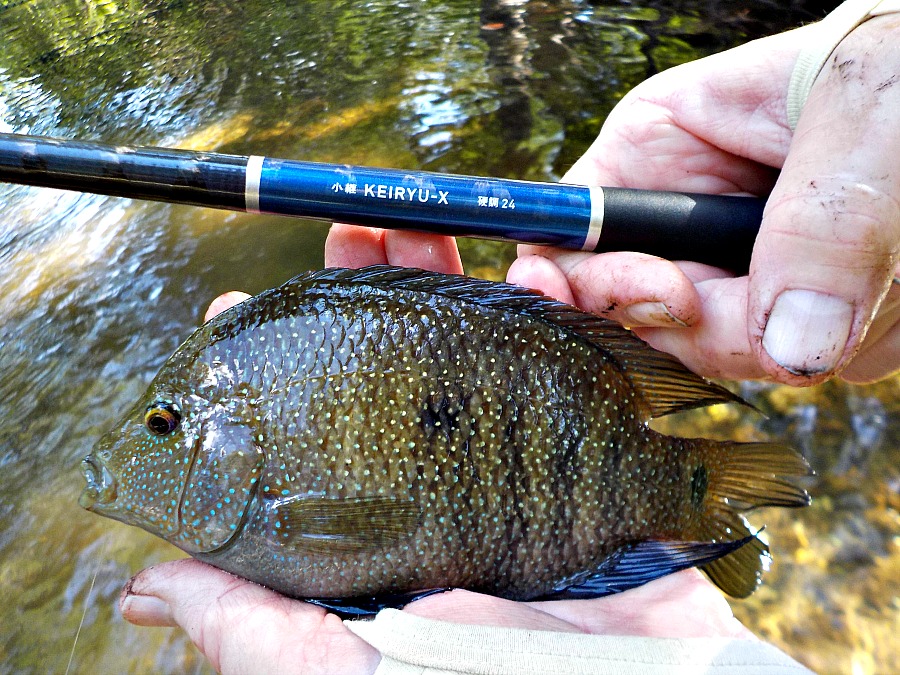 Robin E's Texas Cichlid caught with Keiryu-X 24.
Robin E's Texas Cichlid caught with Keiryu-X 24.As with the Kiyose SF rods they replace, the Keiryu-X comes in lengths ranging from a petite 24 to a beefy 45. I've had people ask me for a rod capable of handling surprisingly large fish in surprisingly small streams. The Keiyru-X 24 will be perfect for them.
As Robin E says, it is for "hefty fish in overgrown streams where you want to keep them away from the snags and roots." And don't think just trout. The Texas Cichlid shown above fights well above its weight and some live in streams where you just can't use a longer rod. Short rods are NOT just for micros!
I've also had people who wanted a rod that was capable of throwing big ugly streamers to big ugly browns (and when the browns get that big, they do indeed get ugly) or pike (which are ugly to begin with). The Keiryu-X 42 and 45 are for them.
Please note: Until I can get some photos with the new Daiwa Keiryu-X rods, most of the photos on the page will be Daiwa Kiyose SF rods.
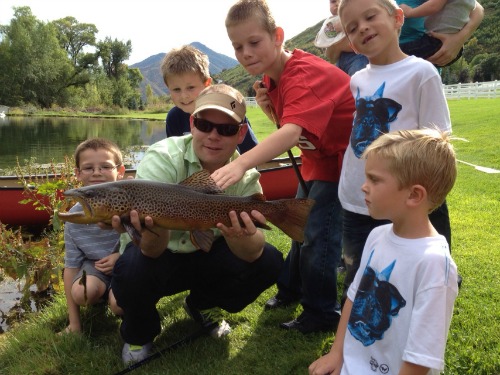
The middle length Kiyose SF rods have been the most popular among
backpackers and Czech Nymphers. They are very light (about 2 ounces) and very compact (under 16"), making them
easy to throw in a pack. Although they're too stiff to cast a
light line, they work well for heavy flies fished with a heavy line. The Daiwa Keiryu-X rods are not too stiff to protect a lighter tippet, though. The rods are rated for tippets ranging from 5X to 7X. The 26" brown shown above was caught with a Kiyose 33SF and 6X tippet.
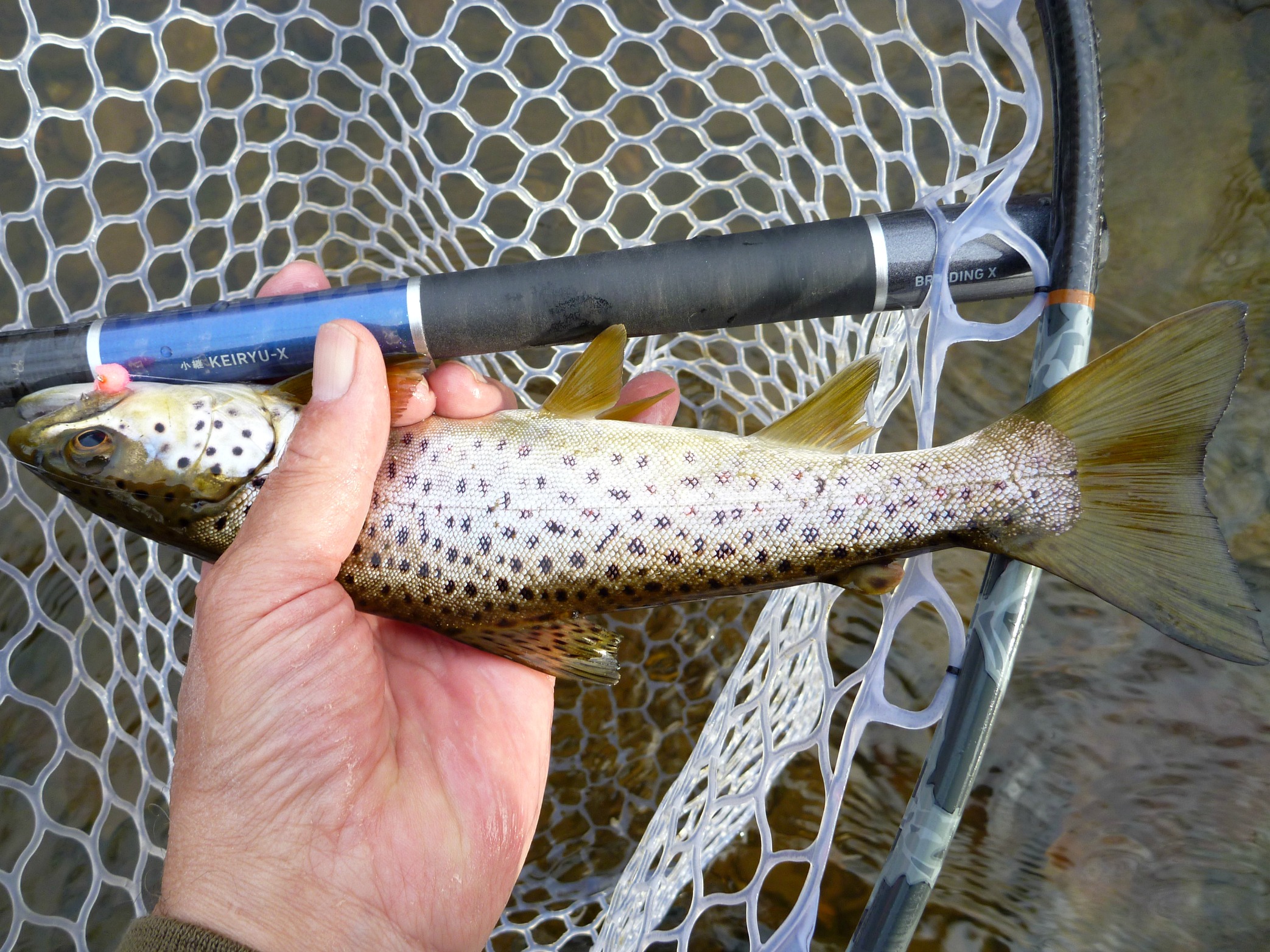 11" brown caught with Keiryu-X 42.
11" brown caught with Keiryu-X 42.Although the rods are quite capable of landing surprisingly large fish, they'll still bend with a smaller fish on the line. You'll feel every head shake, as the rods are very good at transmitting everything that is going on at the other end of the line. You can feel your nymph hit rocks and you can feel fish hit your nymph.
The Daiwa Keiryu-X 42 and 45 are pretty clearly outside the realm of ultralight backpacking. They're for a world of wide rivers and large fish (and at least for the 45, two handed casting). The rods are big and beefy. They have the ability to cast a heavy fly and subdue a heavy fish.
The people who tell
you a big river is just a series of small streams side by side are
wrong. Most small streams aren't 4-6' deep with heavy current. Most
don't hold many fish over 20". In a big river, if there isn't a hatch
going on, you may have to fish deep to catch anything. With
current, if you are going to fish deep you'll need weight. You'll also
need a rod that can handle the hook sets and the fight of a large fish in
current. The Daiwa Keiryu-X 42 and 45 are very good for that kind of fishing.
To get the full potential of the Keiryu-X 42 or 45 I think you will need a heavy line (assuming you are fishing flies). I would use a size 4 or even 4.5 level line or a Nissin PALS SP Pro 4.5m line. To use the rods as keiryu rods, I'd use the Sunline Tenjo line, 4X tippet as a main line and 5X tippet for the hook length. See the Keiryu Lines page for details.
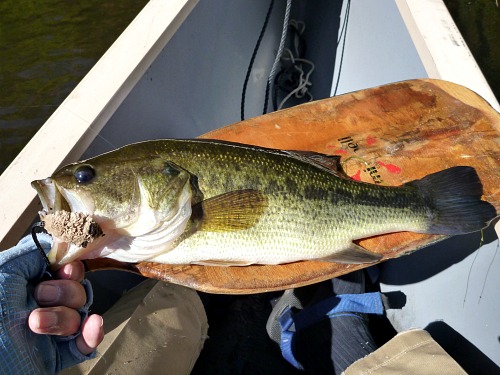 To fish mouse flies you'll need a beefy rod.
To fish mouse flies you'll need a beefy rod.I can see the longer rods being used to cast mouse flies at night for big
browns, or bugs for carp or big deceivers for schoolie stripers. I don't
think they're steelhead rods, but I don't know. I've never tried. For steelhead I would want a longer rod, but if you need big fish capability in a 42 or 45 length rod, particularly one that collapses to a short, convenient length and doesn't break the bank, these are the rods you want.
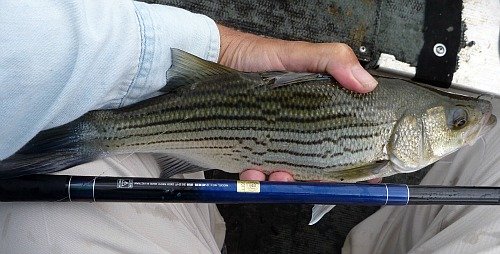 Wiper caught with Daiwa Kiyose SF.
Wiper caught with Daiwa Kiyose SF.Daiwa Keiryu-X Features

Their most distinctive feature is the graphite tape wound in an "X" pattern for the length of the grip section. Daiwa says the "X braiding" reduces twisting, which can reduce power. I suspect it also adds to the stiffness of the grip section. You can feel the tape under the nonskid finish on the grip itself, so it also adds a bit more texture for a better grip with wet hands.

As with other keiryu rods, the grip is a widened out section of the blank itself, coated with an effective nonskid finish.
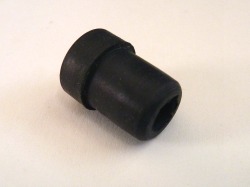
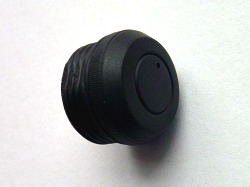
The tip plug is a simple rubber cap that fits very securely and will not fall out when you least expect it. The grip screw cap is knurled for easy tightening or removal, is beveled for comfort and has a ventilation hole.
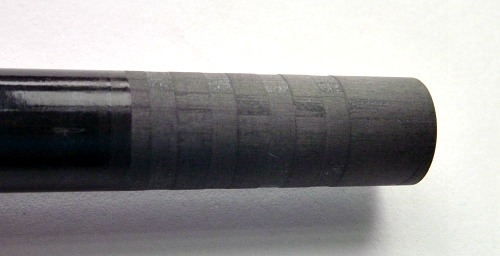
One of the nicest features, and one found only on Daiwa rods, is the series of rings machined into the butt end of the rod sections. The rings do two things: they reduce the hard spot in the bend profile caused by the two layers of tubing where sections overlap and they make it much less likely that you will ever get a stuck section.
Model
Length
Collapsed
Wt oz*
Sections
Tip mm
Butt mm
Carbon %
Tippet
Pennies
24
7'11"
15.6"
1.4
8
0.7
18.5
67%
7X-5X
27
27
9'0"
15.6"
1.6
9
0.7
18.6
72%
7X-5X
29
30
9'11"
15.6"
1.9
10
0.7
18.6
77%
7X-5X
31
33
10'10"
15.6"
2.2
11
0.7
18.6
80%
7X-5X
34
Model
Length
Collapsed
Wt oz*
Sections
Tip mm
Butt mm
Carbon
%
Tippet
Pennies
36
11'10"
15.6"
2.8
12
0.7
20.9
78%
7X-5X
36
39
12'11"
15.6"
3.2
13
0.7
20.9
80%
7X-5X
39
42
13'9"
15.6"
3.6
14
0.7
21.9
82%
7X-5X
42
45
14'8"
15.6"
4.1
15
0.7
22.8
83%
7X-5X
46
*Weight without tip plug
Rods made in Vietnam
TenkaraBum Home > Rods > Daiwa Keiryu-X
“The bitterness of poor quality remains long after the sweetness of low price is forgotten” - Benjamin Franklin
"Be sure in casting, that your fly fall first into the water, for if the line fall first, it scares or frightens the fish..." -
Col. Robert Venables 1662
As age slows my pace, I will become more like the heron.
Warning:
The hooks are sharp.
The coffee's hot.
The fish are slippery when wet.
Beware of the Dogma
This Just In
Suntech Kurenai II AR
Suntech Kurenai PROSPEC 33 (just one rod in stock)
TenkaraBum 33
TenkaraBum 36
Medium Rod Case
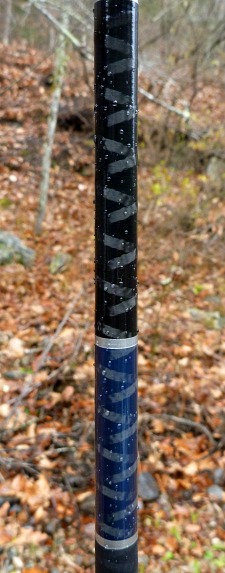
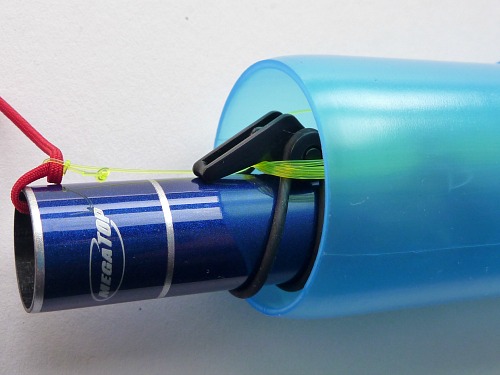 Keiryu-X with Fuji EZ Keepers fits in the Small Rod Case.
Keiryu-X with Fuji EZ Keepers fits in the Small Rod Case.| Hi Chris
I wanted to send you a thank you for a few things; stocking the Daiwa Keiryu-X rods, your “one fly” fishing kits, and your inspiring blog post on tying with the Spring Creek clamps. I had such a blast tying those flies and a great time catching rainbows and browns on them too! What a great introduction to fly tying that is. As for the rod, it’s pretty rare that I have a vision of how something is supposed to work out and the reality matches up, but the 36 I bought feels like I hoped it would (a great nymphing rod). Thanks for your passion for all things Tenkara and for sharing that with others. Dan S, Colorado |
|
Couple of small points of contention - you've misled me.
The new Daiwa 43M is not similar to the old 43MF, its MUCH, MUCH better. I'm also concerned that the new Keiryu-X are similarly superior to the older SFs. They look fantastic. If they perform like they look I'll be junking the old ones. I'll get around to testing them and may have to buy more as spares. You devil. You should update your site and include warnings on how good they are. Craig P, Victoria, Australia |


